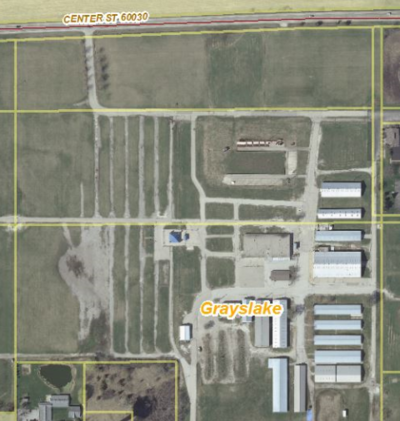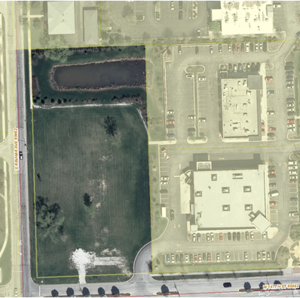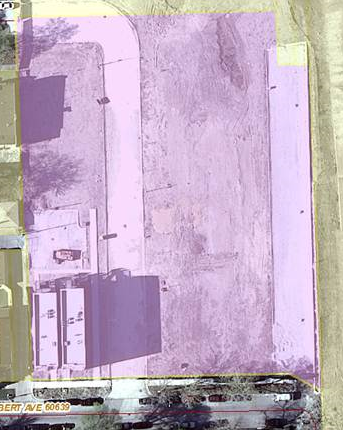Vacant or Under Construction (4000 Series)
Table of Contents
Vacant/Undeveloped Land (4100 Series)
Definition: Land in an undeveloped state, with no agricultural activities nor protection as open space. When land is identified in Assessor data as being Residential, Commercial or Industrial land, it is coded to the corresponding vacant land use (below). Includes razed properties in urban settings.
This does not usually include vacant developed properties where buildings and infrastructure are still intact. In this case, code them to the use they had prior to being vacant or their likely next use, if you know that. Also use the Assessor county code to be your guide. One exception to this is when a building has NO roof on it anymore or it has been vacant for MANY years or even decades and you have learned that shortly after 2010 the building was actually torn down. In this case, you may code it as the appropriate vacant code even though it technically was still standing in spring 2010.
This thinking about when to code a parcel as vacant also holds true for shopping centers. While a shopping center may have anchor stores gone, often it still has some tenants. As long as the building structures are still intact, and despite many vacant spaces, still code it for the intended use, unless the guidelines in the statement above apply such as NO roof, vacant for decades, and you have evidence it was torn down shortly after 2010, so it would be coded vacant.
Vacant Residential Land (4110)
Definition: Undeveloped land classified as “Residential” by county assessor. Includes undeveloped parcels in mature subdivisions (when not owned by an adjacent landowner), as well as undeveloped parcels in newer subdivisions where general construction activities have been completed (and are not owned by an adjacent landowner).
Discussion:
Examples:
Q&A:
- Q: I have seen a number of parcels in residential areas that only have a garage on them or perhaps an old barn. I know that if an adjacent residential parcel has the same owner, then to code these with the same land use as the adjacent parcel and being sure to have zero housing units on this parcel. How do I code such a parcel if no adjacent parcel has the same owner?
- A: If a parcel has been coded by the county as residential; it only has a garage or large barn on it; and no adjacent parcel has the same owner, then code it vacant residential. This would also be the case if the parcel only had rusting junk, shipping containers, old cars or boats, etc. on it and there is no evidence of any commercial or industrial activity such as a Dun & Bradstreet point for a business.
- Q: There are several parcels in residential areas in Markham that have nothing on them. The Taxname is “Moss Sewer Water”. The Contours layer shows that these are NOT retention/detention basins. These parcels do NOT have an adjacent parcel that has a residence on it with the same owner. Some of the parcels have a county use code of 241 Vacant: Vacant land under common ownership with adjacent residence. This is confusing because NONE of these parcels have an adjacent parcel with that same owner of Moss Sewer Water. How do I code these?
- A: Code these as 4110 Vacant Residential. We have found that frequently assessor data in south Cook County did not reflect reality so a common owner for an adjacent residential parcel may have been the case in the past, but no longer true.
Vacant Commercial Land (4120)
Definition: Undeveloped land classified as “Commercial” by county assessor.
Discussion: It is more obvious that land is vacant when there is no building on it or only remains of a demolished building. Classification can be more difficult if buildings are still standing on the property. The general rule is that if you learn that a large property still standing was vacant in spring of 2010 and there is no hope of rehabilitation for the same use, then code the parcels as Vacant Commercial. This category also includes small parcels that only contain a billboard. Billboards are not considered permanent structures, so if the parcel was bought it would be taken down.
Examples:
-
Example 1: Former Fairgrounds. The former fairgrounds in Grayslake in the photo below is an example of there is no hope of rehabilitation for the same use since Internet research reveals a new location for the current Lake County Fair and our NDD reference layer shows a proposed 800,000 sq ft retail operation planned for the site. 4120 Vacant Commercial is appropriate for these parcels since the county classes the them as Commercial.
-
Example 2: Former Rockenbach Chevrolet Dealership buildings. The photo below shows the buildings formerly used by the Rockenbach Chevy dealer. The new dealership is a now a few blocks away. This vacant property is in move-in ready condition so it should be coded 1215 Urban Mix.
Q&A:
- Q: How do I code a theater that I know was vacant in 2010, but the building is still standing and a preservation organization is seeking funding to retore this theater?
- A: Code this as 1240 Cultural/Entertainment. The general rule is that if vacant buildings are still basically functional and therefore could be used for their intended function, then code them with that functional code. So a vacant store building would be coded with one of the retail codes and a vacant theater with the 1240 code.
- Q: I encounter many situations in which one parcel identified as commercial by the county has a particular owner and a building on it. Then another parcel next to this parcel and with the same owner, has absolutely nothing on it. I can see no way that the owner of this parcel is using the second parcel in conjunction with the use on the first parcel. How do I code this second parcel?
- A: If this second parcel truly appears to be vacant and it is big enough to have some sort of significant business activity on it, then code is as vacant. If the parcel is quite small such that no real business activity could occur on it, then code it the same as the first parcel as though it was part of that business land use.
-
Q: How do I code the parcel in the photo below. It is coded as Vacant Land by the county. The tax owner does not match any of the adjacent parcels. About 30% of the parcel’s active use is the retention pond. The other use is passive in that it is vacant. Should this be treated with the 25% rule applied on Ag parcels so it would be Stormwater, 1565 or should the dominant land area be used for the code so it would be Vacant Commercial?
- A: In this case the code to use is 4120 Vacant Commercial even though the non-pond area is “passive”, it has high potential to become an active use since it is situated in the middle of all commercial activity.
Vacant Industrial Land (4130)
Definition: Undeveloped land classified as “Industrial” by county assessor.
Discussion: It is more obvious that land is vacant when there is no building on it or only remains of a demolished building. Classification can be more difficult if industrial buildings are still standing on the property. The general rule is that if you learn that a large property still standing was vacant in spring of 2010 and there is no hope of rehabilitation for the same use, then code the parcels as Vacant Industrial. On the other hand, if the vacant industrial buildings appear to be able to be re-used, then code as the original industrial land use.
Examples:
Q&A:
Other Vacant (4140)
Definition: Undeveloped land classified as “Vacant” or “Agriculture” by county assessor (where less than 25% of the parcel is farmed); or where classification is unknown and there is no evidence of a developed activity or an association with adjacent developed parcels.
Discussion: “Other Vacant” serves as a catch-all for vacant land (with little or no ag activities) where a planned/potential use is not stated in the Assessor data. Most counties have a “vacant” category, although it seems to be inconsistently applied. If a parcel is listed by the Assessor as “vacant,” but is in the middle of a lake, it should be coded Water (5000). If there is evidence of ag activities taking part on more than 25% of the parcel, it should be coded Agriculture (2000).
Examples:
The parcels outlined in red are probably subdivided as part of an industrial development, as evidenced by the Manufacturing parcel in the middle of it. However, the Kane Assessor has these properties listed as “Vacant,” and not “Industrial.” Although your gut tells you to code this as Vacant Industrial, stick with the guidelines and code this 4140 Other Vacant.
Q&A:
- Q: How do I code various sizes and shapes of parcels owned by the State of IL or by a county that have nothing developed on them and are typically among parcels which are commercial, industrial, or residential?
- A: Code these as 4140 Other Vacant. Even though being coded as vacant often means that a parcel has development potential and governments are not usually in the business of land development, someone using the data will be able to use the government ownership in the parcel layer or use other data layers to determine that these parcels, though coded as vacant, do not have development potential.
- Q: How do I code a series of parcels owned by IDOT that appear to form what will be a future expressway? Some parcels appear to be vacant and others currently have crops on them.
- A: Code the vacant parcels 4140 Other Vacant and code the ones with at least 25% agricultural activity as 2000 Agriculture and put a O for Other in the Platted Modifier field for the Ag ones.
- Q: How do I code a parcel that in 2010 is being used for nearby road construction materials and equipment? The county code is VACANT Minor Improvement on Vacant Land. LandUse Pass 1 is Unknown/Misc. Tax Owner is different from adjoining parcels. It was vacant in 2005 and after 2010 became a retail building.
- A: Since this parcel was coded by the county as Vacant and it appears to be temporarily used for a nearby major road construction project, we will follow the lead of the county and code it 4140 Other Vacant.
Under Construction (4200 Series)
Land has been platted for development, and construction activities are evident in aerial imagery (i.e. roadways begun, scraped earth, partially-completed structures, missing or incomplete landscaping). With the exception of Residential properties (see below), each parcel will be evaluated as vacant/construction/finished on a parcel-by-parcel basis.
In some situations, stalled or abandoned construction may be what you see in the aerial photography for the land use year in question. You will often find looking at successive years of aerial photography helpful to support a determination that construction has stalled or was abandoned. It may have been active construction one or more years ago, but from aerial photography, or from other sources, you determine that construction has stopped. If this is the case, code this as “vacant” instead of “under construction”. An obvious example of this is aerial photography that shows a building foundation that is now filled with water and no evidence from any source of active construction happening.
Under Construction, Residential (4210)
Definition: The “construction” designation is applied at the individual parcel (as opposed to the whole subdivision) level, where construction activity (scraped earth, foundations, etc.) are present; this is done to prevent stalled or “ghost” subdivisions from showing up as active developments. Finished structures within these subdivisions will be coded to their finished use.
Discussion:
Examples:
-
Example 1: Conflicting Evidence. You may often find conflicting information in the reference layers with a parcel under construction since the parcel is in transition. In the photo below, the Tax Owner is still Aetna Bearing Company since there had been an industrial building on this parcel in the recent past. The parcel is mostly vacant and Cook County Assessor says this land is vacant, however there are two small buildings in the bottom left of the parcel which Google Street View reveals to be 3-flat apartment buildings. The 2010 aerial photo shows a large dumpster behind these buildings and the Zoning reference layer codes this area as Planned Development. We will go with the more developed landuse of the apartment buildings over the vacant part of the parcel. We will conclude that these buildings are not completed yet because of the dumpster and that more will eventually be built because of the Zoning Code so the code for this will be 4210 Under Construction, Residential.
Q&A:
- Q: What about the common areas of a new development that appear to be finished such as retention ponds in place, bushes planted, etc. but most of the residential lots do not have houses on them yet?
- A: It’s ok to code these common areas in a new development that are basically finished as 1151 Residential Common.
- Q: How do a code a parcel that previously had a very small house on it, but now has a much bigger house which is under construction on this parcel?
- A: If it is obvious that this bigger house is not just a remodel and expansion of the older house, then code it “Under Construction”.
Under Construction, Commercial (4220)
Definition:
Discussion:
Examples:
Q&A:
Under Construction, Industrial (4230)
Definition:
Discussion:
Examples:
Q&A:
Under Construction, Other or Unknown (4240)
Definition:
Discussion:
Examples:
Q&A:




